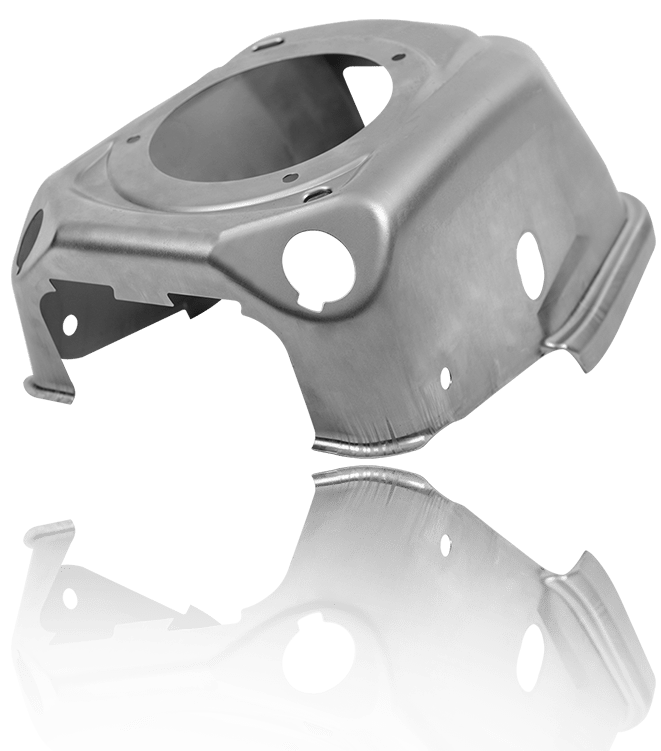The Role of Metal Stamping in Modern Manufacturing and Item Development
The Role of Metal Stamping in Modern Manufacturing and Item Development
Blog Article
Advanced Techniques in Metal Stamping for Precision Production
As markets continuously demand finer tolerances and intricate designs in their steel parts, the pursuit for sophisticated strategies in metal marking has magnified. From the use of innovative multi-stage marking procedures to the assimilation of advanced automation technologies, the landscape of metal stamping is undertaking a profound transformation.
Advanced Multi-Stage Stamping Processes
Going over the details of sophisticated multi-stage stamping procedures exposes the advanced techniques employed in contemporary manufacturing techniques. Metal Stamping. Multi-stage marking is a complicated process that includes numerous actions to change a level sheet of steel right into a final stamped item. Making use of dynamic passes away, where different procedures are performed at each stage of the marking process, permits for high precision and effectiveness in the production of elaborate steel parts
During the initial phases of multi-stage marking, the flat steel sheet is fed into the marking press, where a series of passes away are made use of to reduce and form the product. Succeeding phases involve added forming, flexing, and punching operations to additional fine-tune the component. Each phase is thoroughly designed to build upon the previous one, causing the production of intricate geometries with tight resistances.
Advanced multi-stage stamping procedures call for a high level of knowledge and precision to guarantee the top quality and consistency of the stamped components. By using innovative machinery and tooling, manufacturers can generate a variety of metal elements with efficiency and accuracy.
Precision Tooling Innovations
Accuracy tooling developments have revolutionized the steel stamping sector, improving effectiveness and quality in making processes. These improvements have actually significantly influenced the way steel elements are produced, resulting in higher precision and uniformity in the last products. One essential advancement is the growth of computer system mathematical control (CNC) modern technology in tooling design and fabrication. CNC systems permit intricate designs to be translated straight into tooling, making certain precision and repeatability in the stamping process.
In addition, the integration of sensing units and real-time monitoring capacities in accuracy tooling has actually enabled producers to find and resolve concerns promptly, decreasing downtime and lowering scrap prices. By incorporating clever innovation into tooling, operators can enhance specifications such as stress, rate, and positioning during the stamping procedure, leading to boosted product quality and raised efficiency.

Automation in Steel Stamping
The advancement of accuracy tooling developments in the steel stamping market has paved the way for considerable innovations in automation, transforming the production landscape towards increased performance and performance. Metal Stamping. Automation in steel marking involves the use of sophisticated equipment and robotics to perform numerous jobs traditionally accomplished by human drivers. This shift towards automation offers countless advantages, consisting of improved accuracy, faster production cycles, and decreased labor costs
One trick aspect of automation in metal stamping is click this the execution of computer system numerical control (CNC) systems, which enable precise control over the marking procedure. CNC technology enables the development of facility and intricate metal parts with regular quality. Furthermore, automated systems can be programmed to run continuously, bring about greater result prices and much shorter lead times.
Furthermore, automation improves office safety by decreasing hand-operated handling of hefty materials and reducing the danger of accidents (Metal Stamping). As manufacturing sectors proceed to accept automation, the future of steel marking holds great guarantee for also greater effectiveness and development
High-Speed Stamping Methods

Among the main benefits of high-speed marking techniques useful content is the ability to generate a large volume of parts in a shorter quantity of time compared to traditional stamping methods. This raised performance not just allows makers to meet limited manufacturing deadlines yet likewise makes it possible for cost financial savings via economic situations of scale. In addition, high-speed stamping can help reduce product waste by enhancing the material usage throughout the marking procedure.
In addition, high-speed stamping techniques typically integrate cutting-edge functions such as quick die change systems and real-time tracking capabilities, even more boosting the total effectiveness and versatility of the steel stamping process. As innovation continues to development, high-speed marking is anticipated to play a crucial role in driving the future of accuracy manufacturing.
Quality Assurance in Stamping Workflow
Effective top quality control actions are crucial for ensuring the integrity and uniformity of metal marking procedures. Quality control in stamping operations entails a series of systematic processes intended at identifying and preventing defects in the manufactured parts. One crucial aspect of quality assurance in steel marking is using advanced inspection techniques such as optical evaluation systems and coordinate gauging devices (CMMs) to validate the measurements and tolerances of stamped components.
Furthermore, high quality control measures in stamping operations frequently include the application of analytical procedure control (copyright) techniques to check the manufacturing procedure in real-time and make certain that it continues to be within acceptable limitations. By analyzing information and recognizing patterns, makers can proactively deal with any discrepancies from the desired high quality standards.
Furthermore, top quality control in metal marking operations also entails complete product screening to guarantee that the raw products used satisfy the required requirements for the stamping process. This might consist of conducting product solidity examinations, tensile strength more tips here tests, and dimensional examinations to guarantee the top quality and integrity of the stamped components. Generally, carrying out durable high quality control actions is critical for achieving high-grade stamped components consistently.
Final Thought
Finally, progressed strategies in steel marking play a crucial function in precision manufacturing processes. Through multi-stage marking procedures, innovative tooling options, automation, high-speed methods, and extensive quality control procedures, suppliers can attain higher degrees of precision and efficiency in their operations. These innovations in steel stamping innovation have actually enabled firms to create complicated get rid of tight resistances, ultimately causing improved product high quality and consumer satisfaction in the manufacturing sector.
Report this page